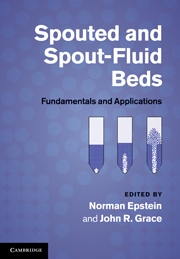Book contents
- Frontmatter
- Contents
- Contributors
- Preface
- Common nomenclature
- 1 Introduction
- 2 Initiation of spouting
- 3 Empirical and analytical hydrodynamics
- 4 Computational fluid dynamic modeling of spouted beds
- 5 Conical spouted beds
- 6 Hydrodynamics of spout-fluid beds
- 7 Spouted and spout-fluid beds with draft tubes
- 8 Particle mixing and segregation
- 9 Heat and mass transfer
- 10 Powder–particle spouted beds
- 11 Drying of particulate solids
- 12 Drying of solutions, slurries, and pastes
- 13 Granulation and particle coating
- 14 The Wurster coater
- 15 Gasification, pyrolysis, and combustion
- 16 Spouted bed electrochemical reactors
- 17 Scaleup, slot-rectangular, and multiple spouting
- 18 Mechanical spouting
- 19 Catalytic reactors and their modeling
- 20 Liquid and liquid–gas spouting of solids
- Index
- References
12 - Drying of solutions, slurries, and pastes
Published online by Cambridge University Press: 04 February 2011
- Frontmatter
- Contents
- Contributors
- Preface
- Common nomenclature
- 1 Introduction
- 2 Initiation of spouting
- 3 Empirical and analytical hydrodynamics
- 4 Computational fluid dynamic modeling of spouted beds
- 5 Conical spouted beds
- 6 Hydrodynamics of spout-fluid beds
- 7 Spouted and spout-fluid beds with draft tubes
- 8 Particle mixing and segregation
- 9 Heat and mass transfer
- 10 Powder–particle spouted beds
- 11 Drying of particulate solids
- 12 Drying of solutions, slurries, and pastes
- 13 Granulation and particle coating
- 14 The Wurster coater
- 15 Gasification, pyrolysis, and combustion
- 16 Spouted bed electrochemical reactors
- 17 Scaleup, slot-rectangular, and multiple spouting
- 18 Mechanical spouting
- 19 Catalytic reactors and their modeling
- 20 Liquid and liquid–gas spouting of solids
- Index
- References
Summary
Introduction
In a system consisting of a liquid and solids dispersed within it, such as slurries and pasty materials, the structure and characteristic properties are defined by the solids concentration, shape, and size distribution. A variety of solid–liquid mixtures, such as suspensions, dispersions, sludges, and pulps, is included in these categories. Solutions with a solute that crystallizes out on evaporation are also included. The drying of solutions in beds of inert particles of spoutable size was developed in the late 1960s at the Lenigrad Institute of Technology for applications in which the dried solids are ultimately required in the form of a fine powder. Spouting with inert particles was applied successfully by the Leningrad group to dry organic dyes and dye intermediates, lacquers, salt and sugar solutions, and various chemical reagents. Since then, a large number of materials have been successfully dried, demonstrating the applicability and versatility of this method. A partial list of dried materials is given in Table 12.1.
Drying process
Description
The drying of pastes (or slurries or solutions, all referred to henceforth in this chapter generically as pastes) is performed in the presence of inert particles, which are both a support for the paste and a source of heat for drying. The paste may be atomized or dropped into the bed by a nozzle or dropping device. An example of an experimental facility for research in paste drying is shown in Figure 12.1.
- Type
- Chapter
- Information
- Spouted and Spout-Fluid BedsFundamentals and Applications, pp. 206 - 221Publisher: Cambridge University PressPrint publication year: 2010
References
- 4
- Cited by



